Файл: Учебное пособие Астрономия. Космическая техника и технологии Алматы, 2012 удк 802. 0 52 629. 7 (0758) ббк 81. Англ. 923.docx
ВУЗ: Не указан
Категория: Не указан
Дисциплина: Не указана
Добавлен: 16.03.2024
Просмотров: 98
Скачиваний: 0
ВНИМАНИЕ! Если данный файл нарушает Ваши авторские права, то обязательно сообщите нам.
MARS: the red planet
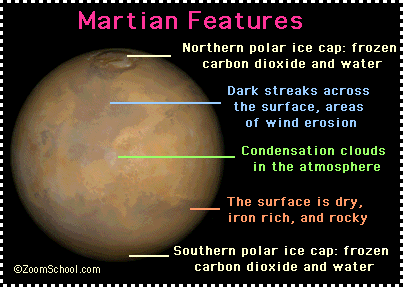
The temperature on Mars can be very, very cold. The iron is what gives Mars
 its red colour. Mars has many craters which were formed by meteorites or asteroids hitting it. Mars also has some of the deepest valleys in our solar system, and it is the home of Olympus Mons, the largest volcano found in the solar system. It stands about 27 kilometers high with a crater 81 kilometers wide. Mars has two moons, Phobos and Deimos.
its red colour. Mars has many craters which were formed by meteorites or asteroids hitting it. Mars also has some of the deepest valleys in our solar system, and it is the home of Olympus Mons, the largest volcano found in the solar system. It stands about 27 kilometers high with a crater 81 kilometers wide. Mars has two moons, Phobos and Deimos.URANUS: Neptune's twin
Uranus is one of the smaller gas giants in our solar system, but it is still large enough to hold 64 planets the size of Earth. Uranus’ axis is at a 97 degree angle, meaning that it orbits on its side! Uranus' atmosphere is made up of hydrogen, helium, and methane. It’s very cold. The cold methane gas is what gives Uranus its blue-green color. Uranus has eleven known rings. Uranus has 18 known moons. Some of these moons are less than 90 miles wide and black as coal.
VENUS: Earth's Twin
Venus is the second planet from the Sun. Venus and Earth are similar in size, composition, and mass. Its t
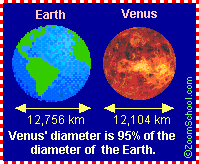 emperature during the day reaches 484 degrees Celsius. It’s so hot it could melt lead cannonballs. The dense atmosphere is composed of carbon dioxide and sulphuric acid, which acts as a greenhouse. Venus is usually visible with the naked eye. Venus is sometimes called the "morning star" or the "evening star." It’s the brightest "star" in the sky. That’s the reason why the ancient people called it Venus, the Roman goddess of love and beauty. Venus is the closest planet to Earth, but it does not have oceans or human life like Earth. The surface of Venus has many craters which were made by meteorites and asteroids crashing into the planet. Venus also has volcanoes. This planet is unusual because it rotates in a direction opposite that of all of the other planets. Venus spins very slowly as it orbits the Sun. A rotation takes 243 Earth days and its orbit takes 225 Earth days, so a Venusian day is longer than a Venusian year.
emperature during the day reaches 484 degrees Celsius. It’s so hot it could melt lead cannonballs. The dense atmosphere is composed of carbon dioxide and sulphuric acid, which acts as a greenhouse. Venus is usually visible with the naked eye. Venus is sometimes called the "morning star" or the "evening star." It’s the brightest "star" in the sky. That’s the reason why the ancient people called it Venus, the Roman goddess of love and beauty. Venus is the closest planet to Earth, but it does not have oceans or human life like Earth. The surface of Venus has many craters which were made by meteorites and asteroids crashing into the planet. Venus also has volcanoes. This planet is unusual because it rotates in a direction opposite that of all of the other planets. Venus spins very slowly as it orbits the Sun. A rotation takes 243 Earth days and its orbit takes 225 Earth days, so a Venusian day is longer than a Venusian year.J
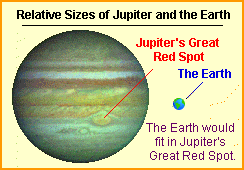 UPITER: the largest planet
UPITER: the largest planetJupiter is the largest planet in the solar system. It is so large that all of the other planets in the solar system could fit inside of it. Jupiter is a large gas planet whose clouds change colours daily. A day on Jupiter lasts only 9 hours and 55 minutes. This planet is made mostly of hydrogen and helium gases. Jupiter gives off two times more heat than it gets from the Sun. It shines very brightly in the night sky for nine months of the year when it is closest to Earth. Jupiter has sixteen known moons. One of Jupiter's moons, Io, has active volcanoes on it.
NEPTUNE: the blue Planet
One Neptune year lasts 165 Earth years! It is so cold on Neptune that you would need skin thicker t
 han a polar bear's to stay warm. Like Uranus, it is a large gas planet that looks like a big blue-green ball in the sky. Neptune has winds in its atmosphere which blow at over 2000 kilometres per hour! Neptune has two thick and two thin rings. Neptune also has eight moons. Four of these moons orbit the planet within the rings. One of Neptune's moons, Triton, orbits the planet in a direction opposite that of the seven other moons. Pluto has got an unusual elliptical shaped orbit, for this reason Neptune can be the farthest planet from the Sun for a 20 year period out of every 248 Earth years.
han a polar bear's to stay warm. Like Uranus, it is a large gas planet that looks like a big blue-green ball in the sky. Neptune has winds in its atmosphere which blow at over 2000 kilometres per hour! Neptune has two thick and two thin rings. Neptune also has eight moons. Four of these moons orbit the planet within the rings. One of Neptune's moons, Triton, orbits the planet in a direction opposite that of the seven other moons. Pluto has got an unusual elliptical shaped orbit, for this reason Neptune can be the farthest planet from the Sun for a 20 year period out of every 248 Earth years.
EARTH: the water Planet
S
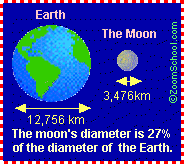 eventy percent of the Earth's surface is covered by water. The remaining 30 percent is covered by mountains, volcanoes, deserts, plains, and valleys Earth is the third closest planet to the Sun. It has an atmosphere made up of many different gases, but mainly it is nitrogen and oxygen. The atmosphere gives us air to breathe. We live on the planet Earth. The Earth orbits around the Sun. It takes one year to orbit the Sun. The Earth also rotates, or spins, on its axis. It takes one day to spin around one complete time. The Earth's axis is not straight up and down, but tilted a little bit. This tilt is responsible for us having seasons. Otherwise, the temperature would be the same all year long.
eventy percent of the Earth's surface is covered by water. The remaining 30 percent is covered by mountains, volcanoes, deserts, plains, and valleys Earth is the third closest planet to the Sun. It has an atmosphere made up of many different gases, but mainly it is nitrogen and oxygen. The atmosphere gives us air to breathe. We live on the planet Earth. The Earth orbits around the Sun. It takes one year to orbit the Sun. The Earth also rotates, or spins, on its axis. It takes one day to spin around one complete time. The Earth's axis is not straight up and down, but tilted a little bit. This tilt is responsible for us having seasons. Otherwise, the temperature would be the same all year long. SATURN: the ringed Planet
S
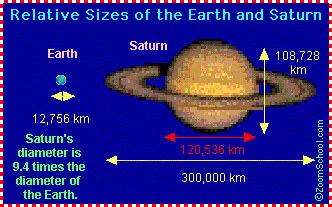 aturn is the second biggest planet, but it’s also the lightest planet. If there was a bathtub big enough to hold Saturn, it would float in the water! It looks like a big ball inside of rings. Saturn's atmosphere has winds which can blow at over 1800 kilometers per hour! The white spots on Saturn are powerful storms. Saturn is surrounded by over 1000 rings made of ice and dust. Some of the rings are very thin and some are very thick. The size of the particles in the rings ranges from pebble-size to house-size. Saturn has at least 18 known moons. Some of these moons orbit the planet within the rings.
aturn is the second biggest planet, but it’s also the lightest planet. If there was a bathtub big enough to hold Saturn, it would float in the water! It looks like a big ball inside of rings. Saturn's atmosphere has winds which can blow at over 1800 kilometers per hour! The white spots on Saturn are powerful storms. Saturn is surrounded by over 1000 rings made of ice and dust. Some of the rings are very thin and some are very thick. The size of the particles in the rings ranges from pebble-size to house-size. Saturn has at least 18 known moons. Some of these moons orbit the planet within the rings.PLUTO: the ice planet
P
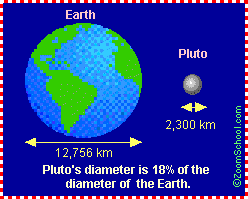 luto is smaller than one of Neptune's moons; Triton Pluto is usually the farthest known planet from the Sun. It has a very unusual orbit. Once every 248 Earth years, Pluto swings inside the orbit of Neptune. It stays there for twenty years. During those twenty years, Pluto is nearer to the Sun than Neptune. While it is nearer to the Sun, Pluto has an atmosphere. The methane and nitrogen frozen at the poles form an atmosphere. Pluto has only one known moon. Pluto's moon, Charon, is half the size of Pluto.
luto is smaller than one of Neptune's moons; Triton Pluto is usually the farthest known planet from the Sun. It has a very unusual orbit. Once every 248 Earth years, Pluto swings inside the orbit of Neptune. It stays there for twenty years. During those twenty years, Pluto is nearer to the Sun than Neptune. While it is nearer to the Sun, Pluto has an atmosphere. The methane and nitrogen frozen at the poles form an atmosphere. Pluto has only one known moon. Pluto's moon, Charon, is half the size of Pluto. Name the planet:
1) Seventy percent of the planet’s surface is covered by water.
2) This planet is the second smallest planet in the solar system.
3) This planet is surrounded by over 1000 rings made of ice and dust.
4) One year on this planet lasts 165 Earth years!
5) This is the largest planet in the solar system
6) Atmosphere of this planet is made up of hydrogen, helium, and methane.
7) This planet has many craters which were formed by meteorites or asteroids hitting it.
8) The dense atmosphere of this planet is composed of carbon dioxide and sulphuric acid, which acts as a greenhouse.
9) This planet has only one known moon, Charon, which is half the size of planet.
Answer the questions:
1) Which planet is the closest to the Sun?
2) Which planet is the largest in Solar System?
3) What is the second largest planet?
4) What is the third planet from the Sun?
5) Which planet lies between Earth and an asteroid belt?
6) What planet is even smaller than Mercury?
7) What planet is called Earth's twin because it is about the same size as Earth?
8) Which planet is the farthest planet from the Sun?
9) Which planet has rings and is about the same size as Neptune?
Crossword “Solar System”

Across
1 The kind of planet that Earth and Mars are.
6 Star at the center of our solar system.
9 This planet is known as the red planet.
10 A hole in the ground caused by a meteor hitting a planet.
13 An outer layer of gas on a terrestrial planet.
15 Planet between Saturn and Neptune.
17 Planets like Jupiter, Saturn, Uranus, and Neptune.
20 A rock that crashes into Earth's atmosphere.
21 The largest planet in the solar system
Down
2 Something that both Saturn and Uranus have.
3 Our planet.
4 An instrument that scientists use to observe planets.
5 Our galaxy.
6 Our sun is this.
7 This used to be called a planet until recently.
8 Planet closest to the sun.
11 Planet named after the sea god
12 Planet known as the evening star.
14 The path that a planet takes around the sun.
16 One of many 'rocks' in a belt between Mars and Jupiter.
17 The force that holds planets in their orbits.
18 Planet famous for its rings.
19 An icy rock that has bright tail when it comes close to the sun.
20 Earth's natural satellite.
Text 5B
The Sun
Our sun is a star located at the center of our Solar System. It is a huge, spinning ball of hot gas and nuclear reactions that lights up the Earth and provides us with heat.
The sun'sabsolute magnitude (its intrinsic brightness) is +4.83. Its stellar type is G (a star that absorbs strong metallic lines in its spectrum).
The Greeks called the Sun "Helios"; the Romans called it "Sol."
Our sun is a medium-sized yellow star that is 93,026,724 miles (149,680,000 km or 1 Astronomical Unit) from the E
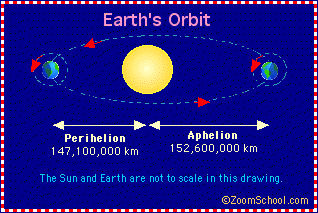 arth.
arth.The Earth is closest to the Sun (this is called perihelion) around January 2 each year (91.4 million miles = 147.1 million km); it is farthest away from the Sun (this is called aphelion) around July 2 each year (94.8 million miles = 152.6 million km).
The Sun's core can reach 10 to 22.5 million°F. The surface temperature is approximately 9,900°F (5,500°C). The outer atmosphere of the Sun (which we can see during a solar eclipse) gets extremely hot again, up to 1.5 to 2 million degrees. At the center of big sunspots the temperature can be as low as 7300 °F (4300 K, 4000 °C). The temperature of the Sun is determined by measuring how much energy (both heat and light) it emits.
The Sun is made up of about 2 x 1030 kilograms of gas. It is composed of about 75% hydrogen and 25% helium. About 0.1% is metals (made from hydrogen via nuclear fusion). This ratio is changing over time (very slowly), as the nuclear reactions continue, converting smaller atoms into more massive ones.
Since the Sun formed 4.5 billion years ago, it has used up about half of its initial hydrogen supply.
Our Sun is a second or third generation star. Second generation stars do not just burn hydrogen, they also burn heavier elements, like helium and metals (elements heavier than hydrogen and helium), and were formed from supernova explosions (the debris of exploded population II stars).
The element helium was named after the Sun (called "Helios" in Greek) because it was first discovered on the Sun. Helium is plentiful on the Sun but rare on Earth. The element helium was discovered by Jules Janssen during the total solar eclipse of 1868 when he detected a new line in the solar absorption spectrum; Norman Lockyer suggested the name helium.
T
 he composition of the Sun is studied using spectroscopy in which the visible light (the spectrum) of the Sun is studied. At the Sun's core, nuclear fusion produces enormous amounts of energy, through the process of converting hydrogen nuclei into helium nuclei (nuclear fusion).
he composition of the Sun is studied using spectroscopy in which the visible light (the spectrum) of the Sun is studied. At the Sun's core, nuclear fusion produces enormous amounts of energy, through the process of converting hydrogen nuclei into helium nuclei (nuclear fusion).Although the nuclear output of the sun is not entirely consistent, each second the Sun converts about 600,000,000 tons of hydrogen nuclei into helium nuclei. These fusion reactions convert part of these atoms' mass (roughly 4 million tons) into energy, and release an enormous amount of this heat and light energy into the Solar System. In these fusion reactions, the Sun loses 4 million tons of mass each second. The Sun will run out of fuel in about 5 billion (5,000,000,000) years. When this happens, the Sun will explode into a planetary nebula, a giant shell of gas that will destroy the planets in the Solar System (including Earth). The Sun formed 4.5 billion years ago, as the solar system coalesced from a cloud of gas and dust. Astronomers study the Sun using special instruments. Scientists analyze how and why the amount of light from the Sun varies over time, the effect of the Sun's light on the Earth's climate, spectral lines, the Sun's magnetic field, the solar wind, and many other solar phenomena. The outer regions of the Sun (the corona) are studied during solar eclipses.
Never look directly at the sun! Looking at the Sun can blind you or cause cataracts. The Ulysses spacecraft, a joint mission of the European Space Agency (ESA) and the National Aeronautics and Space Administration (NASA), was launched from the space shuttle on October, 1990 to explore the sun. It has studied the sun's magnetism, solar prominences and coronal mass ejections (orbiting over the south pole of the Sun in 1994 and over the North Pole in 1995), and will complete a second solar orbit in December, 2001.
Answer the questions:
1) Is the Sun a star, a planet, or a nebula?
2) Is the Sun solid, liquid, or gaseous?
3) During what month is the Sun closest to the Earth?
4) Where is the Sun hottest?
5) Where is the Sun coolest?
6) What element is most plentiful on the Sun?
7) What element was named after the Sun?
8) What is the primary atomic reaction that occurs within the Sun that converts hydrogen atoms into helium atoms?
9) How old is the Sun?
10) Are sunspots hotter or colder than the surrounding areas?
Listening
“A Direct Look at Five Planets Far From Our Solar System”
We are going to listen about planets orbiting stars other than the Sun, remember a huge disaster that struck four years ago and tell how someone you never met can make you happy. For questions 1-9 complete the sentence:
1) Last month, three teams of astronomers reported making direct images of planets orbiting other ___.
2) Today, more than ___ planets have been discovered beyond our solar system.
3) Some planets have been found because they pass ___ the stars they orbit.
4) One team was led by Christian Marois, an astronomer at the Herzberg Institute of Astrophysics in Victoria, Canada. His group found three planets orbiting a star called HR ___.
5) The team used the Keck Two and Gemini telescopes in Hawaii to produce the image showing the planets. The scientists also used a special technology called adaptive ___.
6) Bruce Macintosh of Lawrence Livermore National Laboratory helped make the discoveries. He says all three objects orbit their star in the same direction and plane -- the ___ planets do.
7) A second team announced the discovery of one planet orbiting the star Fomalhaut. Fomalhaut is the ___ brightest star in the sky.
8) Ann-Marie Lagrange of the University of Grenoble led a team that used the Very Large Telescope operated by the European Southern Observatory in Chile. The astronomers found the planet orbiting Beta Pictoris, a star ___ light years away.
9) A team in Thailand reported finding evidence of a tsunami striking that country a few centuries ago. Kruawun Jankaew works at Chulalongkorn University. Her team found sand material that represents a tsunami from ___ to ___ years ago.
Writing workshop idea
You have learned many things about space. You will be taking a space trip. Write a story about your journey into space. What did you see on take-off? How did it make you feel? Where did you go? What did you see while you were there? Are you returning to Earth with a friend or a souvenir? Did you miss your home planet?
Book report questions:
My planet is _____________________.
1 How big is your planet?
2 How many planets is it away from the sun?
3 What is your planet's distance from the earth?
4 Does your planet have any atmosphere?
5 Does your planet have any gravity?
6 Does your planet have any bands or rings?
7 How long does it take for your planet to revolve?
8 How long does it take your planet to rotate?
9 What is your planet's temperature?
10 What planets are on either side of your planet?
11. Tell something interesting that you learned about your planet that you never knew.
Unit 6
Asteroids and Comets
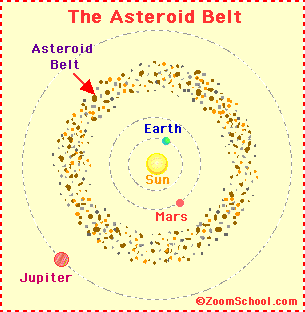 Text 6A
Text 6A
Asteroids
Asteroids are rocky or metallic objects, most of which orbit the Sun in the asteroid belt between Mars and Jupiter. A few asteroids approach the Sun more closely. None of the asteroids have atmospheres.
The asteroid belt is a doughnut-shaped concentration of asteroids orbiting the Sun between the orbits of Mars and Jupiter, closer to the orbit of Mars. Most asteroids orbit from between 186 million to 370 million miles (300 million to 600 million km or 2 to 4 AU) from the Sun. The asteroids in the asteroid belt have a slightly elliptical orbit. The time for one revolution around the Sun varies from about three to six Earth years. The strong gravitational force of the planet Jupiter shepherds the asteroid belt, pulling the asteroids away from the Sun, keeping them from careening into the inner planets.
The asteroid belt is not smooth; there are concentric gaps in it (known as Kirkwood gaps). These gaps are orbital radii where the gravitational forces from Jupiter do not let asteroids orbit (they would be pulled towards Jupiter). For example, an orbit in which an asteroid orbited the Sun exactly three times for each Jovian orbit would experience great gravitational forces each orbit, and would soon be pulled out of that orbit. There is a gap at 3.28 AU (which corresponds to 1/2 of Jupiter's period), another at 2.50 AU (which corresponds to 1/3 of Jupiter's period), etc. The Kirkwood gaps are named for Daniel Kirkwood who discovered them in 1866.
There are about 40,000 known asteroids that are over 0.5 miles (1 km) in diameter in the asteroid belt. About 3,000 asteroids have been cataloged. There are many smaller asteroids. The first one discovered (and the biggest) is named Ceres; it was discovered in 1801.
Asteroids range in size from tiny pebbles to about 578 miles (930 kilometers) in diameter (Ceres). Sixteen of the 3,000 known asteroids are over 150 miles (240 km) in diameter. Some asteroids even have orbiting moons.
Ceres is the largest of the asteroids. It was the first asteroid ever discovered (by the Italian astronomer Giuseppe Piazzi on January 1, 1801). Ceres is the size of the state of Texas! It is so huge in comparison with the other asteroids that its mass is equal to over one-third of the 2.3 x 1021 kg estimated total mass of all the 3,000 cataloged asteroids. Ceres is about 578 miles (930 kilometers) in diameter. Ceres is now considered to be a dwarf planet.
Asteroids can be pulled out of their solar orbit by the gravitational pull of a planet. They would then orbit that planet instead of orbiting the Sun. Astronomers theorize that the two moons of Mars, Phobos and Deimos, are captured asteroids.
The asteroid belt may be material that never coalesced into a planet, perhaps because its mass was too small; the total mass of all the asteroids is only a small fraction of that of our Moon. The total mass of all the asteroids is about 2.3 x 1021 kg ); our moon's mass is 7.35 x 1022 kg; the asteroids' mass combined is about 1/30 of the mass of the Moon. A less satisfactory explanation of the origin of the asteroid belt is that it may have once been a planet that was fragmented by a collision with a huge comet.
Trojan asteroids are asteroids that orbit in gravitationally stable Lagrangepoints in a planet's orbit, either trailing it or preceding it (these places are where the gravitational attraction of the Sun and of the planet balances each other). Jupiter has the most Trojan asteroids; Mars also has some. Achilles was the first Trojan asteroid found. The asteroids preceding Jupiter in its orbit were named for Greek heroes; those following Jupiter in its orbit were named for Trojan heroes.
Answer the questions:
1) The asteroid belt orbits between two planets ___ and ___.
2 Are all the asteroids in the asteroid belt?
3) Are asteroids bigger or smaller than planets?
4) What are asteroids composed of?
5) What may have caused the mass extinction on Earth 65 million years ago (the extinction that killed the dinosaurs)?
6) Name another group of organisms that went extinct during this mass extinction.
7) What is the name of the biggest asteroid (and the first one discovered)?
8) What is another name for asteroids?
9) Do any of the asteroids have a moon orbiting them?
